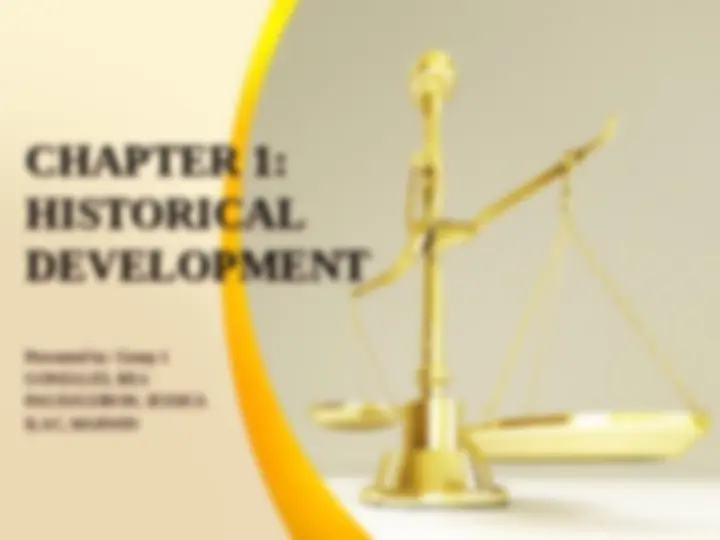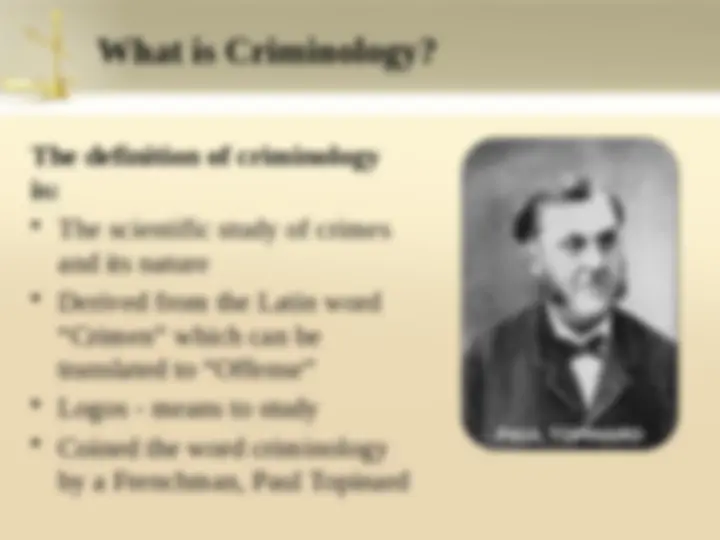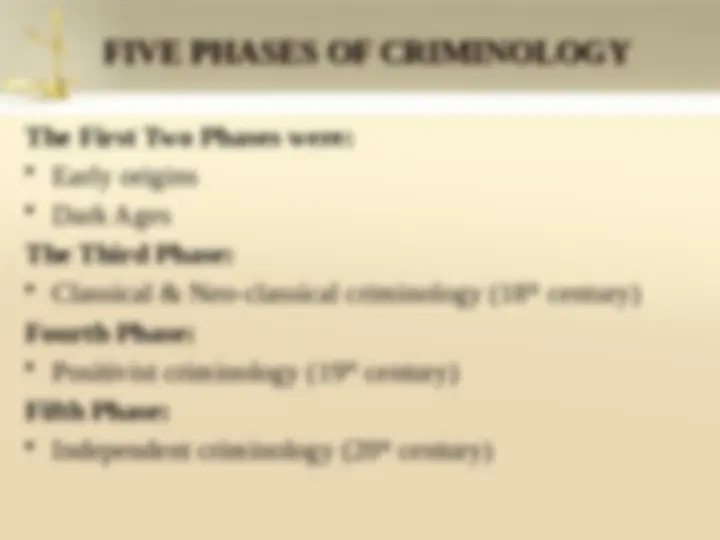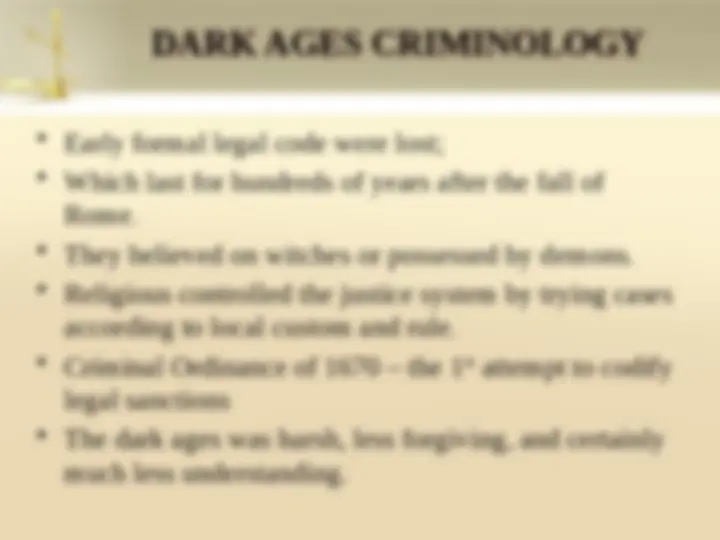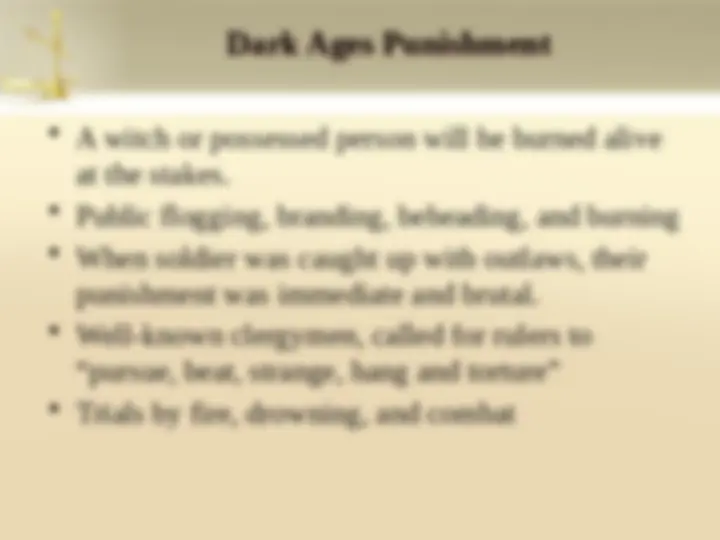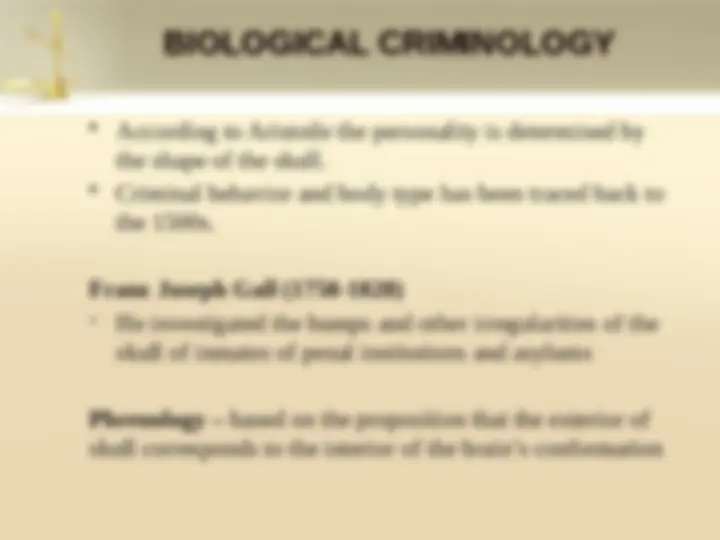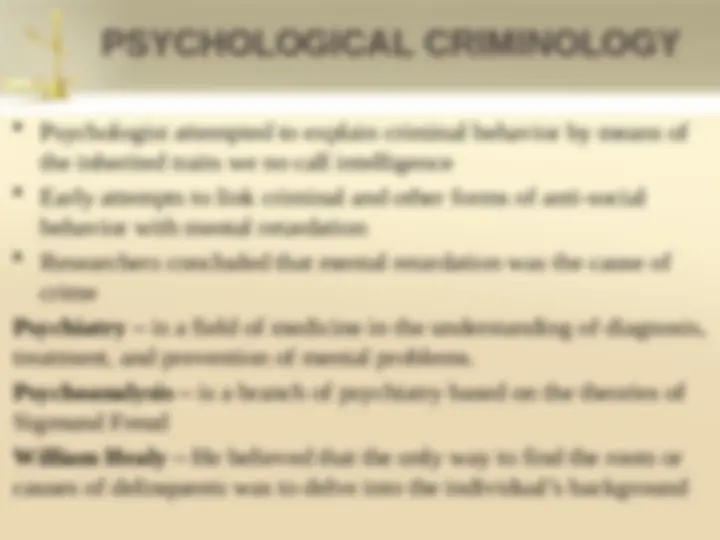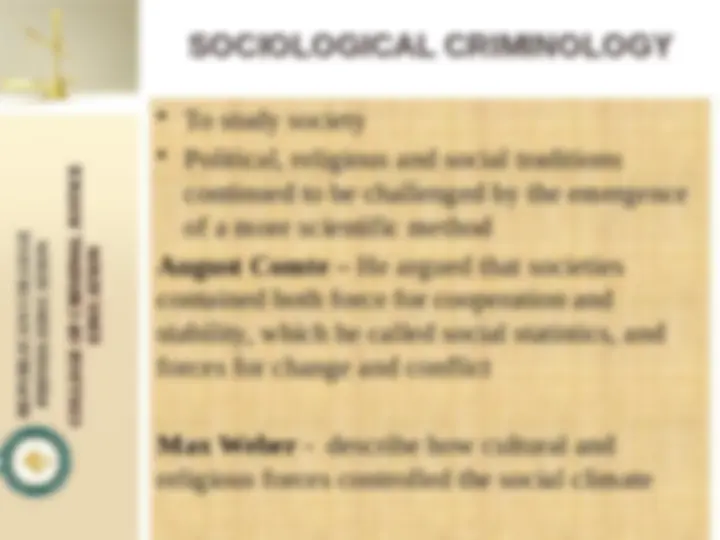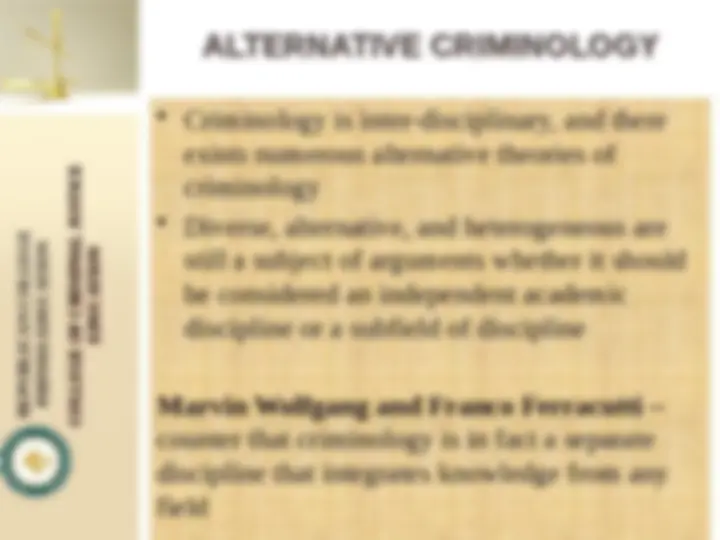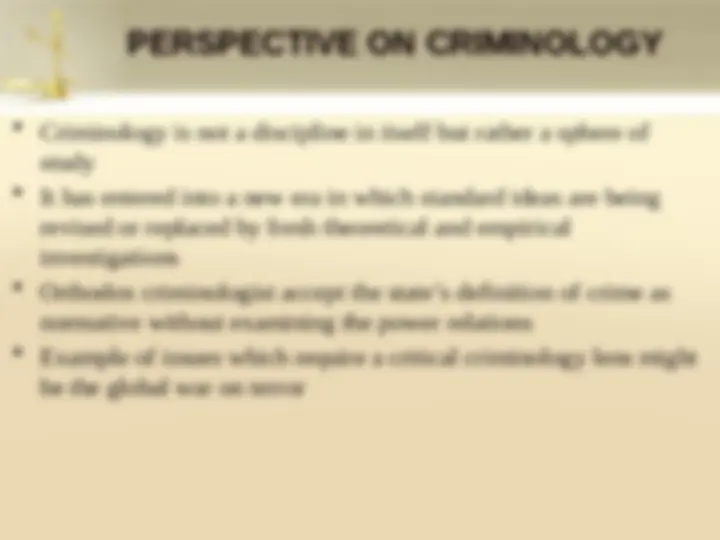Download CHAPTER 1: Historical Development Of Criminology and more Slides Criminology in PDF only on Docsity!
COLLEGE OF CRIMINAL JUSTICE
EDUCATION
COLLEGE OF CRIMINAL JUSTICE
EDUCATION
REPUBLICAN COLLEGE
PHINMA EDUCATION
REPUBLICAN COLLEGE
PHINMA EDUCATION
The definition of criminology is:
- (^) The scientific study of crimes and its nature
- (^) Derived from the Latin word “Crimen” which can be translated to “Offense”
- (^) Logos - means to study
- (^) Coined the word criminology by a Frenchman, Paul Topinard What is Criminology? PAUL TOPINARD
FIVE PHASES OF CRIMINOLOGYFIVE PHASES OF CRIMINOLOGY The First Two Phases were:
- (^) Early origins
- (^) Dark Ages The Third Phase:
- (^) Classical & Neo-classical criminology (18th^ century) Fourth Phase:
- (^) Positivist criminology (19th^ century) Fifth Phase:
- (^) Independent criminology (20th^ century)
Code of Hamurabi (1750-1799 B.C)
- (^) is a well-known example of the ancient precept of "lex talionis," or law of retribution, a type of retaliatory justice associated with the phrase "an eye for an eye.“ Mosaic Code (1200 B.C)
- (^) The foundation of Judeo-Christian moral teachings, but it is also a basis for the U.S. legal system Roman Law/Twelve Tables (451 B.C)
- (^) Were formulated by a special commission of ten men in response to pressure from the lower classes, the plebeians.
ANCIENT LEGAL CODE ANCIENT LEGAL CODE
REPUBLICAN COLLEGE PHINMA EDUCATION COLLEGE OF CRIMINAL JUSTICE EDUCATION COLLEGE OF CRIMINAL JUSTICE EDUCATION
DARK AGES CRIMINOLOGYDARK AGES CRIMINOLOGY
- (^) Early formal legal code were lost;
- (^) Which last for hundreds of years after the fall of Rome.
- (^) They believed on witches or possessed by demons.
- (^) Religious controlled the justice system by trying cases according to local custom and rule.
- (^) Criminal Ordinance of 1670 – the 1st^ attempt to codify legal sanctions
- (^) The dark ages was harsh, less forgiving, and certainly much less understanding.
- (^) Life was still harsh
- (^) The people lived in terrible squalor
- (^) Less than of all people born reached 20
- (^) Only 30% made it to age 40
- (^) The primary food was bread, often baked in huge loaves
- (^) The urban poor drink foul water and rancid food
- (^) Alcoholism was a significant problem
- (^) The overpopulated and underfed cities became breeding grounds for crime
- (^) In England, law reform acts of 1772 and 1758 added more than 350 crimes for which the punishment was death
- (^) Crime was viewed as a rebellious act against the political structure
- (^) In later decades, unfair punishments, inherited power etc. would help produce revolutions first in the American colonies, then in France, and much later Russia.
CLASSICAL AND NEO-CLASSICAL
th
Century)
CLASSICAL AND NEO-CLASSICAL
th
Century)
REPUBLICAN COLLEGE PHINMA EDUCATION COLLEGE OF CRIMINAL JUSTICE EDUCATION COLLEGE OF CRIMINAL JUSTICE EDUCATION
POSITIVIST CRIMINOLOGY ( th Century) POSITIVIST CRIMINOLOGY ( th Century)
- (^) The scientific method began to take hold in Europe
- (^) New discoveries in biology, astronomy, and chemist Two main elements of Positivist Criminology 1 st - The belief that human behavior is a function of external forces that are beyond individual control. 2 nd - The embrace of the scientific method to solve problems.
- (^) They challenged the concept of “soul” that cannot be verified by the scientific method
- (^) Cult of science - All human activity could be verified by scientific principles
- (^) Survival of the fittest – A process of evolution and natural selection in which the strongest survived
- (^) Positivism dominated all scientific inquiry and was considered the modern way of doing things.
BIOLOGICAL CRIMINOLOGYBIOLOGICAL CRIMINOLOGY
- (^) According to Aristotle the personality is determined by the shape of the skull.
- (^) Criminal behavior and body type has been traced back to the 1500s. Franz Joseph Gall (1758-1828)
- (^) He investigated the bumps and other irregularities of the skull of inmates of penal institutions and asylums Phrenology – based on the proposition that the exterior of skull corresponds to the interior of the brain’s conformation
PSYCHOLOGICAL CRIMINOLOGYPSYCHOLOGICAL CRIMINOLOGY
- (^) Psychologist attempted to explain criminal behavior by means of the inherited traits we no call intelligence
- (^) Early attempts to link criminal and other forms of anti-social behavior with mental retardation
- (^) Researchers concluded that mental retardation was the cause of crime Psychiatry – is a field of medicine in the understanding of diagnosis, treatment, and prevention of mental problems. Psychoanalysis – is a branch of psychiatry based on the theories of Sigmund Freud William Healy – He believed that the only way to find the roots or causes of delinquents was to delve into the individual’s background
INDEPENDENT CRIMINOLOGYINDEPENDENT CRIMINOLOGY
- (^) While Carl Marx did not attempt to develop a theory of crime and justice, his writing were applied to legal studies
- (^) This writings laid the foundation for Marxist criminology
- (^) Marxist theory had an important impact on criminology
- (^) The assassinations of John Kennedy and Martin Luther King symbolized the feeling that people who fought for freedom and equality would be crushed by the system they opposed
- (^) Biological and psychological views of crime have also undergone considerable evolution.
- (^) Criminologist no longer believed that a single trait or inherited characteristics can explain crime
- (^) Some are convinced that biological and psychological traits interact with environmental factors to influence all human behavior, including criminality
- (^) Sociological theories have continued to dominate the field
CONTEMPORARY CRIMINOLOGYCONTEMPORARY CRIMINOLOGY
REPUBLICAN COLLEGE PHINMA EDUCATION COLLEGE OF CRIMINAL JUSTICE EDUCATION COLLEGE OF CRIMINAL JUSTICE EDUCATION
PERSPECTIVE ON CRIMINOLOGYPERSPECTIVE ON CRIMINOLOGY
- (^) Criminology is not a discipline in itself but rather a sphere of study
- (^) It has entered into a new era in which standard ideas are being revised or replaced by fresh theoretical and empirical investigations
- (^) Orthodox criminologist accept the state’s definition of crime as normative without examining the power relations
- (^) Example of issues which require a critical criminology lens might be the global war on terror

